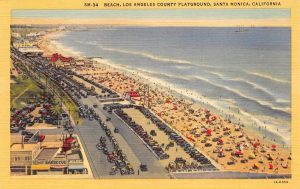 I’m delighted to introduce the Coastal History blog’s fifth guest post (and the third guest post in the last twelve months!). Elsa Devienne is a Fellow at the Princeton Mellon Initiative in Architecture, Urbanism, and the Humanities. She also holds a position as ‘maîtresse de conferences’ in the department of American studies at Université Paris Nanterre.
I’m delighted to introduce the Coastal History blog’s fifth guest post (and the third guest post in the last twelve months!). Elsa Devienne is a Fellow at the Princeton Mellon Initiative in Architecture, Urbanism, and the Humanities. She also holds a position as ‘maîtresse de conferences’ in the department of American studies at Université Paris Nanterre.
She is currently working on a book project titled Shifting Sands: A Social and Environmental History of Los Angeles’s Beaches. Using a wide range of data, from engineering reports to popular literature, municipal archives, photographs, and urban planning documents, Devienne traces the transformation of the city’s beaches from relatively untouched natural spaces into artificial playgrounds for the wealthy. Her publications are available at https://u-paris10.academia.edu/ElsaDevienne
In this post, she discusses new work on the urban beach, a topic that has featured in this blog previously here, and also in the post on The Political Economy of Sand. Dr. Devienne’s conference report serves as another reminder that some of the best practitioners of Coastal History are scholars who come to watery topics from “outside,” bringing fresh energy and genuinely different perspectives. For other examples, some context, and even a Venn diagram, see my post on the Firths and Fjords blog. –I.L.
What is the relationship between the Burkini controversy, which divided French politicians last summer, the Rainbow beach ‘swim-ins,’ which took place in Chicago in 1960, and the leisure activities of Palestinian refugees on Beirut’s women-only beaches? All these activities—whether they are considered political or not—have taken place on a unique urban space that has inspired much scholarship recently: the urban beach.
On November 10th, the School of Advanced Study at the University of London hosted an informal workshop to discuss recent research related to urban beaches, from issues of design and urban planning, to the hidden meanings of beach-going in a tense urban context. Organized by Dr Claire Launchbury, the workshop offered geographical and cultural diversity, with presentations dedicated to Beirut, Paris, and Los Angeles. As an object of enquiry, the urban beach lands itself to different disciplinary approaches and the workshop also reflected this variety with researchers using the methodological tools of history, anthropology, urban studies, and political science.
Laleh Khalili, Professor of Middle East Politics in the Department of Politics and International Studies at the School of Oriental and African Studies (SOAS), presented a keynote on the politics of leisure in Lebanon entitled ‘Promenading on the Corniche and Beachgoing in Beirut.’ Her presentation was based on an article she recently published in Environment and Planning D: Society and Space (accessible here). Professor Khalili prefaced her presentation by explaining the challenges she faced coming to this topic from a decade of scholarly work on prisons, torture, and issues of mourning and memory in the contemporary Middle East.
Yes, the beach was a more ‘fun’ topic, she acknowledged, but she did want the leisure activities of the young Palestinian women she followed for two years to be taken seriously. Even though in appearance their bikini-wearing and shisha-smoking did not seem to warrant much attention, Professor Khalili argued that in the context of Beirut—where the cramped refugee camps of Burj al-Barajna and Shatila stand not too far from the city’s beautiful sandy beaches—these activities have meaning.
Professor Khalili also wanted to go beyond the usual divide scholars of leisure have drawn between (to put it briefly) “leisure as a form of infrapolitics” and “leisure as frivolous consumerist practice.” While the women themselves did not conceive of their weekend activities as political, Khalili argued that the anonymity and class, national, and gender fluidity of the Corniche allow these women to have access to a public life without surveillance—something that is impossible in the close quarters of the camps. According to Khalili, the conviviality Palestinian women find in these spaces of leisure is of utmost importance: it allows them to ‘overcom[e] atomisation or individuation’ (Khalili, 2015) in the context of tensions splitting the country apart.
Professor Khalili’s presentation led to a lively discussion on past and present scholarship on the topic of leisure. I was reminded of my initial doubts when I chose to study Los Angeles’s beaches—a topic which may appear as ‘frivolous’ at first glance. Initially, these doubts led me to investigate the technological feats behind the making of the Los Angeles coastal landscape. As I discovered while researching my dissertation, the beaches of Los Angeles are actually as artificial as those that spring up on the banks of the Seine River in Paris every summer. In some cases, the city’s beaches were enlarged three to four times their original sizes via artificial sand nourishments. Focusing on the papers of engineers and urban planners and their vision for the future of the city’s coastline made me feel more legitimate as a researcher. Surely, if engineers and urban planners had produced countless reports and plans on the beaches, nobody could contest that it was “serious” matter.
But I soon discovered that the technological history behind the making of the Los Angeles’s beaches was directly connected to histories of the body, gender, and sexuality—in other words to the supposedly ‘frivolous’ aspects of beach studies. In my presentation, which gave an overview of my current book project, I explained how these different threads were connected to each other. Tentatively entitled Shifting Sands: A Social and Environmental History of Los Angeles’s Beaches, my book project looks at the transformation of Los Angeles’s beaches in the twentieth century from relatively untouched natural spaces into artificial playgrounds for the wealthy.
 Between the 1920s and the 1960s, engineers, city officials, urban planners, and businessmen worked together to clean up and enlarge the beaches and develop parking lots, freeways, elite clubs, theme parks, and high-rises on the sands. By imposing order on the beach, city leaders hoped to attract the white, middle-class residents on the shore. While the push for what I call “beach modernization” only lasted for a few years, it had a deep impact on who had the ‘right to the beach’ to paraphrase Henri Lefebvre. Indeed, modernizing the beaches involved the destruction of the traditional leisure spaces of working-class youths, gay men and women, and black beachgoers. It also led to the closing of famed ‘Muscle Beach,’ an informal outdoor gymnasium where unconventional bodies and gender performances were on display. There was no space for these unconventional athletes on the “modern” beaches engineers and urban planners had envisionned. Thus beach modernization contributed to the erasure of alternative beach cultures.
Between the 1920s and the 1960s, engineers, city officials, urban planners, and businessmen worked together to clean up and enlarge the beaches and develop parking lots, freeways, elite clubs, theme parks, and high-rises on the sands. By imposing order on the beach, city leaders hoped to attract the white, middle-class residents on the shore. While the push for what I call “beach modernization” only lasted for a few years, it had a deep impact on who had the ‘right to the beach’ to paraphrase Henri Lefebvre. Indeed, modernizing the beaches involved the destruction of the traditional leisure spaces of working-class youths, gay men and women, and black beachgoers. It also led to the closing of famed ‘Muscle Beach,’ an informal outdoor gymnasium where unconventional bodies and gender performances were on display. There was no space for these unconventional athletes on the “modern” beaches engineers and urban planners had envisionned. Thus beach modernization contributed to the erasure of alternative beach cultures.
Next and last was Dr Dominic Glynn’s presentation on ‘Paris Plages,’ the fake beaches that appear every summer in different parts of Paris. As a specialist of contemporary French theatre, it is not entirely surprising that he was drawn to the ‘urbeach,’ as this strange phenomenon of recreating sandy beaches in the middle of cities has been called. The décor at ‘Paris Plages’ looks very much like a theater set with props picked at random to evoke the seaside—from palm trees typical of Mediterranean beaches to colourful cabins reminiscent of Normandy’s coastline. Created in 2002 by former socialist mayor Bertrand Delanoë, Paris Plages has enjoyed a great success and has expanded from its initial central location to other neighborhoods of Paris farther away from the city’s touristic attractions, prompting the addition of an –s to the initial denomination of ‘Paris Plage.’
Glynn’s presentation reminded me of the fact that the first artificial beach of such kind was created in London in 1934 when 1,500 tons of sand were dumped along the Thames below the Tower of London. Tower Beach, as it was called, enjoyed a large success throughout its existence, especially with the lower classes who could not afford a trip to the seaside towns. Offering a beach experience to those cannot afford it is a common rhetoric used to promote ‘Paris Plages’ today. But the question of whether the beaches are actually used mostly by tourists, or by local residents deprived of summer vacations, is left open.
What the three presentations and the following discussion demonstrated is that beaches in an urban context are fundamentally political spaces. As large public spaces where people from all walks of life can shed their “urban” persona for an afternoon and experiment with their bodies and sexualities, they generate heated debates related to public order, public access, and racial and gender mixing. But in order to investigate these debates, researchers need to move beyond a reductionist view of urban beaches as tourist attractions and look at them as multidimensional urban spaces.










Comments are closed.